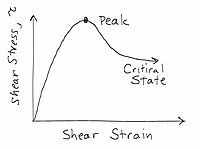
Photo from wikipedia
Abstract Stability analysis of strain-softening slopes is carried out using the shear strength reduction method and Mohr-Coulomb model with degrading cohesion and friction angle. The effect of strain-softening behavior on… Click to show full abstract
Abstract Stability analysis of strain-softening slopes is carried out using the shear strength reduction method and Mohr-Coulomb model with degrading cohesion and friction angle. The effect of strain-softening behavior on the slope factor of safety is investigated by performing a series of analyses for various slope geometries and strength properties. Stability charts and equations are developed to estimate the factor of safety of strain-softening slopes from the results of traditional stability analysis based on perfectly-plastic behavior. Two example applications including an open pit mine in weak rock and clay shale slope with daylighting bedding planes are presented. The results of limit equilibrium analysis and shear strength reduction method with perfectly-plastic models were in close agreement. Using perfectly-plastic models with peak strength properties led to overly optimistic results while adopting residual strength properties gave excessively conservative outcomes. The shear strength reduction method with a strain-softening model gave realistic factors of safety while accounting for the process of strength degradation.
Journal Title: Journal of rock mechanics and geotechnical engineering
Year Published: 2020
Link to full text (if available)
Share on Social Media: Sign Up to like & get
recommendations!